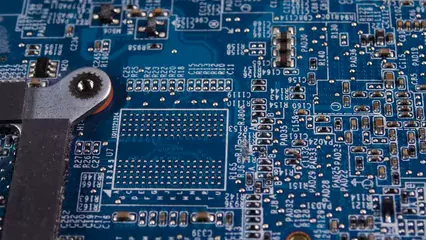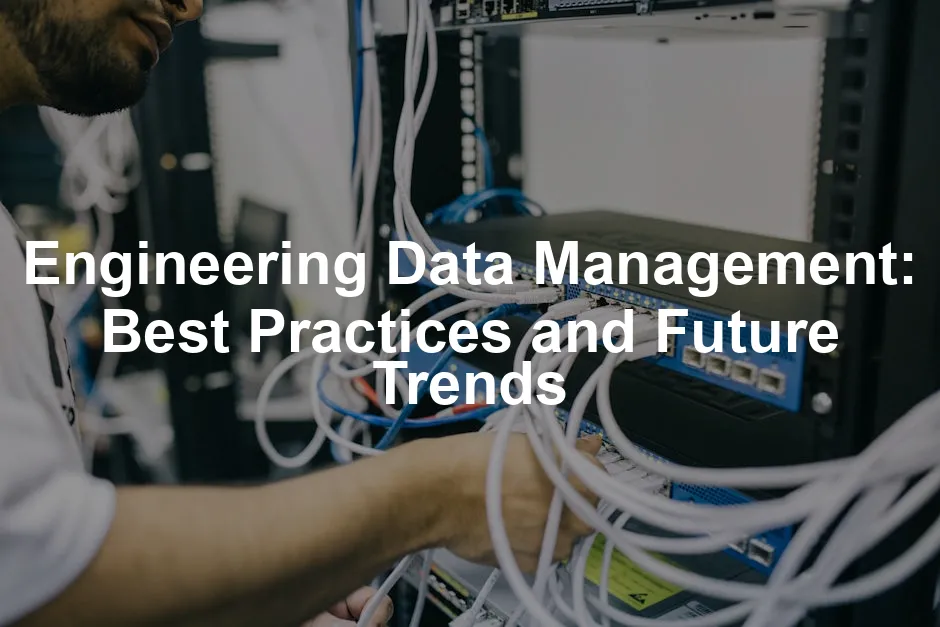Introduction
Engineering Data Management (EDM) is vital in engineering-driven industries. It ensures accurate data handling throughout product development. This article will discuss best practices and future trends in EDM, helping organizations optimize their processes.
Summary and Overview
Engineering Data Management refers to the systematic organization of data throughout a product’s lifecycle. It encompasses data collection, storage, and governance, ensuring all stakeholders can access current and accurate information. Effective EDM enhances collaboration among teams, improves decision-making, and ensures compliance with industry regulations. Key components include data governance, version control, and integration with other systems. Implementing a robust EDM system leads to significant benefits, such as reduced errors, improved efficiency, and streamlined workflows, ultimately enhancing product quality and market responsiveness.

Speaking of enhanced efficiency, consider incorporating Document Management System (DMS) Software into your processes. It can make organizing and retrieving critical documents a breeze, saving you time and headaches!
What is Engineering Data Management?
Definition and Scope
Engineering Data Management (EDM) involves managing technical data throughout the product lifecycle. This includes stages like concept development, design, and manufacturing. EDM ensures that all relevant data is captured, organized, and easily accessible.
EDM processes include data acquisition, storage, and analysis. Organizations in manufacturing, automotive, and aerospace rely on EDM for efficient operations. In these industries, managing vast amounts of data is crucial for innovation and compliance. Effective EDM supports product development by ensuring data integrity and consistency.
By implementing EDM, companies can foster collaboration across departments. This holistic approach to data management enables teams to work together seamlessly, improving overall project outcomes. In summary, EDM plays a critical role in managing the engineering data lifecycle, ensuring that information flows smoothly across all stages of product development.
The Importance of Engineering Data Management
Engineering Data Management (EDM) is crucial for organizations in engineering-driven fields. It offers several critical benefits that enhance overall productivity and collaboration.
First, EDM significantly boosts data integrity and consistency. By establishing a centralized system, all stakeholders access the same accurate data. This reduces the chances of errors and ensures everyone is on the same page. Imagine being on a sports team where everyone uses the same playbook; it just makes sense!
Next, EDM streamlines operations and decision-making. With organized data at your fingertips, teams can make informed choices quickly. This agility leads to faster project turnaround times and better resource allocation. Research shows that organizations implementing EDM experience up to a 30% increase in operational efficiency.
Furthermore, EDM encourages engineering collaboration. Teams can share documents, designs, and data effortlessly, breaking down silos that often hinder progress. Real-time access to information fosters innovation. When engineers collaborate seamlessly, creativity flourishes.
Lastly, compliance becomes more manageable with effective EDM systems. By adhering to industry regulations and data governance principles, organizations minimize legal risks. This proactive approach protects both the company and its clients.
In summary, Engineering Data Management is vital for enhancing collaboration, ensuring data integrity, and driving efficiency and compliance. By prioritizing EDM, organizations can pave the way for innovation and success in their projects.

Key Components of EDM
Data Governance and Policy
Data governance is essential for effective EDM. Establishing clear frameworks and standards ensures that data management activities are compliant and consistent. This structure helps mitigate risks and enhances data quality. Organizations should implement policies that dictate how data is collected, stored, and accessed. Using software tools like data governance platforms can streamline these processes and improve accountability.

Data Acquisition and Capture
Successful EDM begins with data acquisition. This involves collecting information from various sources, both internal and external. Techniques like automated data capture and validation ensure accuracy and reliability. Software tools equipped with data validation features help prevent errors at the source. This foundational step allows organizations to maintain high data quality throughout the lifecycle.
Data Storage and Organization
Efficient data storage is crucial for accessibility. Organizations need to choose appropriate storage solutions, whether cloud-based or on-premises. Implementing classification systems helps categorize data, making retrieval easy. Using databases or document management systems (DMS) can enhance data organization. This accessibility not only saves time but also supports collaboration across teams.

Data Integration and Analysis
Integrating diverse data sources is vital for comprehensive insights. Techniques such as ETL (Extract, Transform, Load) facilitate the merging of data from various platforms. By utilizing analytics tools, organizations can uncover trends and make data-driven decisions. This integration leads to a unified view of information, enhancing overall operational effectiveness. Don’t forget to explore AI-Powered Data Analysis Tools to supercharge your data insights!
Data Maintenance and Lifecycle Management
Ongoing data management practices are essential for maintaining data quality. This includes regular audits, backups, and version control. Implementing a data lifecycle management system ensures that data is accurate and relevant. By using automation tools, organizations can streamline these maintenance tasks, reducing manual workload and improving efficiency.

In conclusion, the key components of Engineering Data Management—data governance, acquisition, storage, integration, and maintenance—are vital for maintaining high data quality and enhancing overall operational efficiency. By investing in these areas, organizations can better manage their engineering data throughout its lifecycle. Additionally, consider exploring tips for effective data analysis in economics and statistics to further enhance your data management strategies.
Implementing effective data analysis techniques can significantly improve your EDM processes. tips for effective data analysis in economics and statistics
Challenges in Engineering Data Management
Managing engineering data poses several hurdles for organizations. One primary challenge is the sheer volume and diversity of data. As projects progress, teams generate extensive documentation, from CAD files to specifications. This data comes from various sources, often in different formats, making organization difficult.
Another significant issue is ensuring data quality and compliance. Inconsistent data can lead to costly errors. Organizations must constantly monitor and validate data to maintain its integrity. Compliance with industry regulations adds further complexity, as organizations must ensure that their data management practices meet legal standards.
Tackling these challenges requires strategic approaches. First, organizations can implement robust data governance policies. These policies should outline how data is collected, stored, and accessed. Regular audits can also help maintain data quality. Investing in advanced data management tools can streamline processes. These tools can automate data validation, version control, and access management, ensuring secure and efficient data handling.
Furthermore, promoting a culture of collaboration among teams can enhance data management practices. By sharing knowledge and resources, teams can work more effectively, reducing the risk of data silos. Additionally, consider using a Wireless Router for Enhanced Connectivity to ensure that your team stays connected, no matter where they are!

Best Practices for Effective EDM
To establish and maintain effective Engineering Data Management (EDM) systems, organizations should follow several best practices. First, developing a comprehensive data management strategy is essential. This strategy should set clear goals, define roles, and outline workflows for data handling. By having a structured approach, teams can ensure consistency and accountability in their data management practices.
Ensuring data quality and consistency is another critical aspect. Organizations should adopt standardized data formats and conduct regular audits to detect and correct inaccuracies. Implementing data validation techniques at the point of entry can significantly enhance the quality of the data collected.
Collaboration and knowledge sharing are vital for successful EDM. Encourage teams to utilize collaborative tools that facilitate real-time sharing and updating of information. Establishing a centralized data repository allows all stakeholders to access the same information, promoting transparency and reducing errors.

Investing in reliable EDM tools can also streamline these processes. Solutions like Product Lifecycle Management (PLM) Software can integrate various data sources and provide a single source of truth. These tools often come equipped with features like document management, version control, and analytics capabilities to enhance data visibility and accessibility.
Lastly, organizations should prioritize training and support for their teams. Providing ongoing education ensures that all employees understand the importance of effective data management. By fostering a data-driven culture, organizations can maximize the benefits of their EDM systems, ultimately leading to improved efficiency and innovation.

Tools and Technologies for EDM
Overview of Essential Tools
In the realm of Engineering Data Management (EDM), having the right tools is crucial. Various software solutions enhance the efficiency of managing engineering data. Let’s explore some key categories.
Product Lifecycle Management (PLM) software is fundamental for managing product-related data throughout its life. It integrates various processes, keeping everything from design documents to compliance records in one place. Imagine having a digital library that evolves with your product!
Computer-Aided Design (CAD) software allows engineers to create detailed 2D and 3D models. This software streamlines design processes, ensuring accuracy and facilitating collaboration. You can easily share designs with your team, making feedback more effective.
Document Management Systems (DMS) play a vital role in organizing project documents. These systems ensure that critical data is easily accessible and secure. Version control features prevent confusion, allowing teams to track changes and maintain data integrity.

Cloud-based solutions are increasingly popular in EDM. They offer scalability and accessibility, enabling teams to access data from anywhere. This flexibility supports real-time collaboration, which is essential in today’s fast-paced environments. Don’t forget to check out Cloud Storage Solutions like Amazon S3 for your data needs!
In summary, leveraging these EDM tools—PLM, CAD, DMS, and cloud solutions—can significantly enhance data management processes. They not only streamline workflows but also improve collaboration and data security.

Future Trends in Engineering Data Management
Emerging Technologies
The future of Engineering Data Management is shaped by several exciting trends. As technology evolves, so does the way we handle data.
Artificial Intelligence (AI) is making waves in data processing. It automates routine tasks, allowing teams to focus on critical analysis. AI algorithms can analyze vast amounts of data quickly, providing insights that drive informed decisions. Imagine having a virtual assistant that helps you make sense of your data!
The Internet of Things (IoT) is another game changer. With numerous devices connected, data generation is skyrocketing. IoT devices collect real-time information, which can be invaluable for project management. This constant flow of data requires robust management strategies to ensure that the information collected is useful and secure. Don’t miss out on the latest IoT Devices to enhance your data collection!

Additionally, cloud technologies are set to redefine data management. They offer flexible storage solutions and enable seamless integration across platforms. The shift towards cloud-based EDM systems enhances collaboration and scalability, which is vital for modern engineering projects.
In conclusion, AI, IoT, and cloud technologies are transforming Engineering Data Management. Embracing these trends will enable organizations to optimize processes, enhance collaboration, and drive innovation in their projects.
Conclusion
Effective Engineering Data Management (EDM) is essential for organizations aiming to thrive in engineering-intensive fields. It facilitates better collaboration, enhances data integrity, and ensures compliance throughout the product lifecycle. By implementing best practices and embracing emerging technologies, companies can optimize their data management processes. This not only leads to improved efficiency but also fosters innovation and reduces operational risks. As EDM continues to evolve, organizations should remain proactive in adopting the latest tools and strategies to stay competitive. Embrace the future of data management and watch your projects soar!
FAQs
What is the primary goal of Engineering Data Management?
The primary goal of EDM is to ensure that all engineering data is accurately managed throughout the product lifecycle. This includes maintaining data integrity, accessibility, and compliance, which are crucial for successful product development.
How does EDM improve collaboration within teams?
EDM enhances collaboration by providing a centralized platform for data sharing. Teams can access current information, reducing silos and enabling real-time communication. This unity fosters better teamwork and accelerates project outcomes.
What are common software solutions used in EDM?
Common EDM software solutions include Product Lifecycle Management (PLM) tools, Computer-Aided Design (CAD) software, and Document Management Systems (DMS). These tools streamline data organization, version control, and collaboration.
Why is data security important in EDM?
Data security is vital in EDM to protect sensitive engineering information from unauthorized access. Ensuring data privacy helps maintain compliance with regulations and safeguards intellectual property, reducing the risk of data breaches.
What are the benefits of using cloud solutions for EDM?
Cloud EDM solutions offer scalability, accessibility, and enhanced collaboration. They allow teams to access data from anywhere, streamline workflows, and provide real-time updates, making them an excellent choice for modern engineering projects.
Please let us know what you think about our content by leaving a comment down below!
Thank you for reading till here 🙂
All images from Pexels




